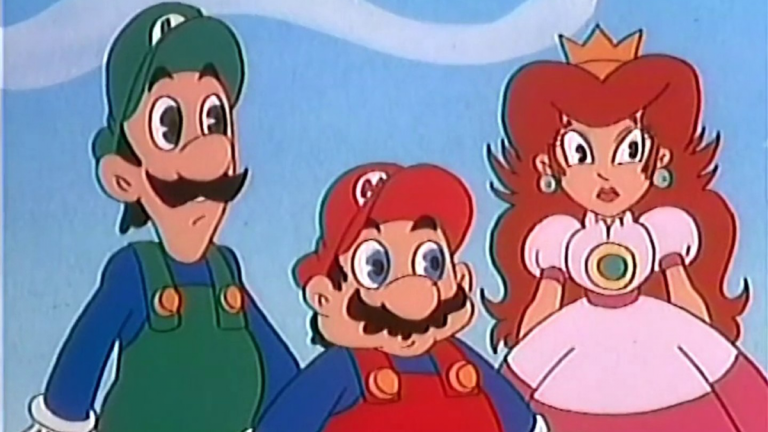Remembering the Chaotic Super Mario Bros. Super Show
Years before the Super Mario Bros. came to the big screen, a curious TV project brought the Mushroom Kingdom to the masses.

With anticipation for Illumination’s The Super Mario Bros. Movie reaching a fever pitch, fans of Nintendo’s most famous character are finding all the ways they can to tide themselves over before the film’s theatrical release on April 5. Whether it’s going back and playing the classics of the Mario franchise over again, or simply reminiscing about the Mushroom Kingdom’s best moments with friends, the film is a special entertainment event.
While some folks may have felt that adapting Mario and his pals for the big screen was a novel concept, taking a trip back to the 1980s would allow you to discover that the plumber has already been transported to the television set decades in the past. The Super Mario Bros. Super Show was the first of three syndicated Mario animation series that aired between 1989 and 1991. If you grew up a gamer during this era, you probably remember watching at least a few episodes of this short-lived cult classic. There was also the infamous Super Mario Bros. live-action film from 1993 starring Bob Hoskins and John Leguizamo, but … we don’t talk about that around here.
The Super Mario Bros. Super Show starred WWF wrestler Lou Albano and Danny Wells as Mario and Luigi, respectively. The show was split into live-action segments and cartoon ones, with the brothers portrayed by Albano and Wells in both capacities. This choice led to some cumbersome acting and a tone that was clearly directed towards a very youthful audience. If you watch the show today, it serves as a time capsule to a very different decade, but often not in a good way.
The Cornier, The Better?
Look, Mario and the Mushroom Kingdom aren’t really meant to be adapted to a different medium besides video games. While kids and adults alike wanted as much of the Nintendo mascot in their lives as possible, some characters and universes are better left untouched. Gaming allows people to dissociate from reality in a way they simply can’t in other forms of entertainment. Television and film often requires a certain semblance of realism to capture our adulation. Video games are a free-for-all of chaotic creativity and genius ideas manifested.
The Super Mario Bros. Super Show is one of the corniest displays of slapstick and schmucky comedy you could imagine seeing, whether watching it in the 1980s or in the 2020s. Seeing Albano and Wells in costume as Mario and Luigi looks like something out of a satirical skit show. The men would even stand out even at a Halloween party or a cosplay convention due to their over-the-top delivery of lines and cheesy mannerisms.
All of this doesn’t have to sound as harsh as it seems on the surface. The point of the show wasn’t to win any Emmys, but rather give fans of Mario and Luigi a chance to see their favorite game characters in a different light. Their screen presence may be comforting to some, but seeing two middle aged dudes in colorful overalls makes the whole idea of the Mushroom Kingdom seem sillier than we want it to. Fortunately, the game translates better to a cartoon than a live-action scenario, if only for a little bit.
A Mario Cartoon, or a Cartoon About Mario?
Mario games have never been about the plot. We know the basics: Bowser captures Princess Peach and Mario comes to save her. End of the story and we start over again in the next game. This makes coming up with episodic storylines a difficult endeavor, and it certainly was arduous for the crew of The Super Mario Bros. Super Show.
The Mushroom Kingdom has many characters to play around with, but the writers still seemed stuck in the mud often. Capture and rescue plots were repeated redundantly, and episodes were often inspired by or spoofed other animated franchises like Aladdin. One early season episode used a character named Mark Twang (a nod to Mark Twain), which shows how desperate the writers were for ancillary characters.
These decisions make the show often feel like a cartoon simply set in Mario’s world rather than one about Mario and his pals. The distinction is easy to see when watching the action, and the same can be said about other animation like Netflix’s The Cuphead Show! Other classic anime like Pokémon do a fantastic job of building upon the world of the video games they’re derived from, but the material is also easier to adapt.
The whole experience often feels like a potpourri of experimentation, and not necessarily in a good way. Each episode ended with a preview of The Legend of Zelda animated series that would air on Fridays each week in syndication. Obviously these programs were all directed at the same audience: if you like Mario, you probably also enjoy the adventures of Link in Hyrule.
What Can The Super Mario Bros. Movie Learn From The Super Show?
The best thing that can be said about The Super Mario Bros. Super Show is that it can be used as a template for The Super Mario Bros. Movie. Illumination is obviously going in a completely different direction than this retro cartoon. The film has a massive budget and an enormously famous voice cast.
Mario’s creator Shigeru Miyamoto was an active participant in the film’s inception and creation, therefore the core ideas of the series should be featured prominently. The movie is supposed to be a massive feast for the casual eye rather than junk food for the gaming enthusiast. People are going to watch the movie whether they’ve played Mario’s games or not and this makes the plotting much easier for the directors and writers to grapple with.
Trailers and teasers show impressive graphics and animation that couldn’t be replicated in a cartoon of the 1980s. CGI fits the Mushroom Kingdom like a glove. This helps The Super Mario Bros. Movie focus on environment and tone instead of random storylines like in The Super Mario Bros. Super Show. Illumination has a great chance to help movie-goers feel immersed in the setting of Mario in a whole new way.
Maybe the best thing Nintendo nuts can do is accept that their nostalgia often tempts them to ask for more than Mario can provide for them. Audiences should lower their expectations, understand the lack of flexibility in adapting Mario for the screen, and just have some fun at the theater!
